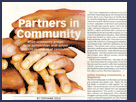

|
||||
| Partners in Community: When community groups forge partnerships with school districts in support of curriculum goals, everyone wins. by Stephanie Gold In the Hilltop neighborhood of Tacoma, Wash., community ties were sadly missing from the middle-school experience. “Middle school students didn’t know what existed outside their own little world,” says Kurt Miller, program director of TEACH Tacoma, an initiative of the Northwest Leadership Foundation. “Kids didn’t know what was out there for them,” he adds. “So we asked community people to visit us—architects, service dog trainers, somebody with a falcon—they sit at a lunch table and the kids come to them.” The weekly visits don’t have community members doing a big speech, they just talk to the kids one-on-one, or more often, twenty-on-one. Today, four Hilltop schools are served by a creative network of after-school classes, summer enrichment activities, and more in alliance with groups such as the Boys & Girls Club and Metro Parks. In St. Louis, the Cable Television Education Commission (CableTEC) was formed when a portion of the local cable company’s franchise fee was dedicated to education. Recently, CableTEC introduced topic-specific grants to inspire new creative partnerships, focusing on topics such as Lewis & Clark, health and fitness, and the arts. These theme grants are generating considerable community involvement, reaching out to organizations as diverse as the Discovery Expedition, National Park Service, the St. Louis Department of Health, the St. Louis Fire Department, and local arts organizations such as Sculpture Park and Young Audiences. “Every time we do a grant with a school we’re forming partnerships,” says Marlene Sachs. “The teachers meet with us, present to their peers, and they partner with all these different groups in the community.” Sachs adds that grants foster passion, “and when teachers have passion, they’re better, more effective teachers, and the learning process is greater.” Utilize Existing Community Resources One example is the Maxine Mimms Academy, a program for suspended and expelled youth. It pre-existed TEACH Tacoma, but was expanded and supported through a grant. One 7th grader had a mother getting cancer treatments. The boy was kicked out of school for disruptive behavior, but the Academy staff found he was so worried, he just needed to call his mother during the day, to hear her voice. With that phone call allowed, his internal problems resolved considerably. He’s back in school, with no Academy re-visits. In fact, no children this year have had a single suspendable slip-up after receiving Academy support. In St. Louis, CableTEC’s health and fitness grants sponsor student video-production programs that partner with a dozen St. Louis health organizations. The students are creating public service announcement videos about health. Representatives from throughout St. Louis, including the Heart Association, the Police Department, the American Red Cross, the Dental Hygienists, Cardinal Glennon Hopsital, and Fontbonne University’s Dietician program, brought the community into the classrooms by visiting schools and expanding students horizons, instructing on health practices, and in the process, informing kids about the health organizations in their city. Then the students integrated that instruction with their technical skills and put the message back out to the community via their public service announcements the students created then shared on their cable network. Collaboration Sparks Passion The Lewis & Clark grants in St. Louis likewise kindled ingenuity. The Core Discovery people—a costumed re-enactment group sailing keelboats up the Missouri River—partnered with St. Louis and enlivened their curriculum. Teachers were on the trail with a satellite feed, writing curriculum. One teacher even played Meriwether Lewis. Marlene Sachs, CableTEC Utilization Director, says, “They did science experiments, math applications, art projects. It was so cross-curricular!” To start germinating ideas for the 2005-06 school year, CableTEC’s upcoming Show Me Networks Conference has presentations from nine local arts groups, from crafts to circus arts to theater. Teachers will rub elbows with artists and, hopefully, initiate partnerships and generate creative grant proposals for 2006. By putting all the players at the same lunch table, the CableTEC hopes to fuel the collaborative energy that sustains their topic-specific grant proposals. “We’re going to encourage teachers to meet with artists,” explains Sachs. “They’ll create partnerships with the arts, whatever groups they choose, and apply for a grant for next year. That’s how we reach out to the community.” Tap Community Leaders Sustainable Community Centered Partnerships Connect to Home |
||||
